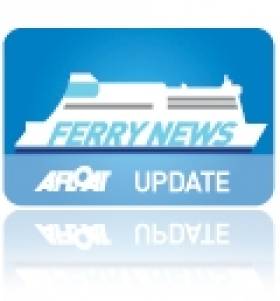Displaying items by tag: RoPax BenMyChree
Final Manx-Dublin Seasonal Service Sailings
#ISLE OF MAN FERRY – This weekend will see the final round-trip of seasonal Douglas-Dublin sailings operated by the Isle of Man Steam Packet Company.
The ro-pax ferry Ben-My-Chree is scheduled to depart Douglas tomorrow evening at 19.30hrs with an arrival in Dublin Port on (Sunday30 December) just after midnight at 00.15hrs.
The ferry will make her return departure to the Isle of Man, departing Dublin Ferryport at 01.00hrs with an arrival at the Manx capital scheduled for 05.45hrs.
For sailing schedules including Manx-UK routes, click HERE.
Dublin-Douglas December Winter Sailings
#MANX FERRY- In preparation for the busy festive season, the Isle of Man Steam Packet Co. (IOMSPCo) are to deploy Ben-My-Chree to operate two round-trip Douglas-Dublin Port crossings, writes Jehan Ashmore.
The ro-pax (90-freight trailer/630 passenger) ferry is scheduled to depart Douglas on Saturday 22 December at 19.30hrs with an arrival in Dublin Port at 00.15hrs on the morning of Sunday 23 December. The return sailing departs the Irish capital at 01.00hrs.
On the following weekend, Ben-My-Chree heads for the 4 hour 45 minute Irish route again on Saturday 29 December, departing Douglas at 19.30hrs and arriving in Dublin just after mid-night at 00.15hrs. The return crossing on Sunday 30 December to the Manx capital departs 01.00hrs.
For updates on sailing schedules to include Manx-UK routes between Douglas-Heysham and the winter only operated Douglas-Liverpool (Birkenhead) route visit: www.steam-packet.com/en/LatestSailings
Ferry Changes on Dublin-Isle of Man Route
#FERRY NEWS- This weekend's round-trip Douglas-Dublin sailings are to be served by fast-ferry Manannan (1998/5,743grt) instead of conventional ferry, writes Jehan Ashmore.
Usually these winter sailings are operated by Ben-My-Chree (1998/12,504grt), as the Dutch built ro-pax is in dry-dock at Cammell Laird, Birkenhead for repairs to her bow-thruster.
The InCAT built Manannan will cover these sailings with an arrival in Dublin Port this evening at 22.00hrs. She spends a short-around in port lasting only 45 minutes, before returning to the Manx capital.


























































